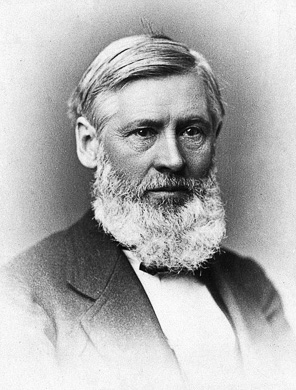BOTANY FOR YOUNG PEOPLE AND COMMON SCHOOLS
How Plants Grow
A Simple Introduction to Structural Botany
by Asa Gray
Originally published in 1858 and now in the public domain.
CHAPTER II.
HOW PLANTS ARE PROPAGATED OR MULTIPLIED IN NUMBERS.
SECTION IV. -- Fruit and Seed.
§ 1. Seed-Vessels.
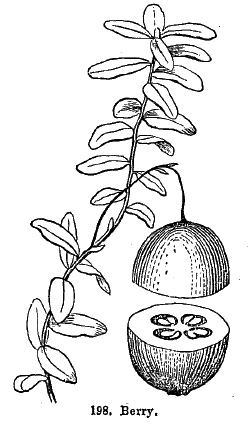
220. AFTER the flower comes the Fruit. The ovary of the flower becomes the Seed-vessel (or Pericarp) in the fruit. The ovules are now seeds.
221. A Simple Fruit is a seed-vessel formed by the ripening of one pistil (with whatever may have grown fast to it in the flower, such as the tube of the calyx in many cases, 217). Simple fruits may be most conveniently classified into Fleshy Fruits, Stone Fruits, and Dry Fruit.
222. The principal sorts of fleshy fruits are the Berry, the Pepo, and the Pome.

223. A Berry is fleshy or pulpy throughout. Grapes, tomatoes, gooseberries, currants, and cranberries are good examples. (Fig. 198 shows a cranberry cut in two.)
Oranges and lemons are only a kind of berry with a thicker and leathery rind.
224. The Pepo or Gourd Fruit (such as a squash, melon, cucumber, and bottle-gourd, Fig. 199) is only a sort of berry with a harder rind.
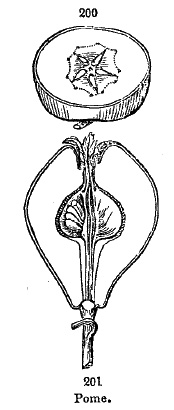
225. A Pome or Apple-Fruit is the well-known fruit of the Apple, Pear, Quince, and Hawthorn. It comes from a compound pistil with a coherent calyx-tube (that is, from such a flower as Fig. 194), and this calyx, growing very thick and fleshy, makes the whole eatable part or flesh of the fruit in the haw and the quince.
The real seed-vessels in the quince (Fig. 201), apple (Fig . 200) , and the like, consist of the five thin, parchment-like cells of the core, containing the seeds.
In the quince, all the flesh is calyx.
But in the pear and apple the flesh of the core, viz., all inside of the circle of greenish dots which are seen on cutting the apple across (Fig. 200), belongs to the receptacle of the flower, which here rises so as to surround the real seed-vessels.
Cutting the apple lengthwise, these dots come to view as slender greenish lines, separating what belongs to the core from what belongs to the calyx; they are the vessels which in the blossom belong to the petals and the stamens above.
In the haw, the cells become thick and stony, and so form a kind of
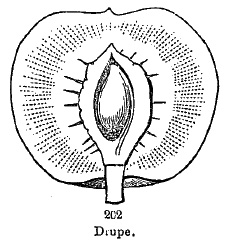
226. Stone-Fruit or Drupe. Plums, cherries, and peaches (Fig. 202), are the commonest and best examples of the stone-fruit. It is a fruit in which the outer part becomes fleshy or pulpy, like a berry, while the inner part becomes hard or stony, like a nut.
So the Stone (or Putamen, as the botanist terms it) does not belong to the seed, but to the fruit. It has the seed in it, with coats of its own.
227. Dry Fruits are those that ripen without flesh or pulp. They are either dehiscent or indehiscent.
Dehiscent seed-vessels are those which split or burst open, in some regular way, to discharge the seeds.
Indehiscent seed-vessels are those that remain closed, retaining the seed until they grow or until the seed-vessel decays. All stone fruits and fleshy fruits are of course indehiscent.

228. The sorts of indehiscent dry fruits that we need to distinguish are the Akene, the Grain, the Nut, and the Key.
229. The Akene includes all dry, one-seeded, closed, small fruits, such as are generally mistaken for naked seeds; such, for instance, as the little seed-like fruits of Buttercups. (Fig. 203 is one of these, whole, a good deal enlarged; Fig. 204, one with part of the wall cut away.)
That they are not seeds is plain from the way they are produced, and from their bearing a style or stigma, at least when young. They are evidently pistils ripened, and on cutting them open, the seed is found whole within (Fig. 204).
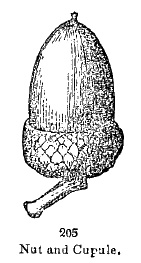
230. A Grain (or Caryopsis) is the same as an akene, except that the thin seed-vessel adheres firmly to the whole surface of the seed.
Indian corn, wheat, rye, and all such kinds of grain are examples.

231. A Nut is a hard-shelled, one-seeded, indehiscent fruit, like an akene, but on a larger scale. Beechnuts, chestnuts, and acorns (Fig. 205) are familiar examples. In all these the nut is surrounded by a kind of involucre, called a Cupule or Cup, which, however, is no part of the fruit.
In the Oak, the cupule is a scaly cup; in the Beech and Chestnut, it is a kind of bur; in the Hazel, it is a leaf-like cup or covering; in Hop-Hornbeam, it is a thin and closed bag. The fruit of the Walnut, Butternut, and the like, is between a drupe and a nut, having a fleshy outer layer.
232. A Key or Key-Fruit (called by botanists a Samara) is like an akene or nut, or any other indehiscent, one-seeded fruit, only it is winged.
The fruits of the Ash (Fig. 206) and of the Elm (Fig. 207) are of this kind. That of the Maple consists of two keys partly joined at the base, both from one flower (Fig. 208).
233. Dehiscent Fruits, or dry fruits which split or burst open in some regular way, take the general name of
234. Pods. These generally split lengthwise when ripe and dry. Pods formed of a simple pistil mostly open down their inner edge, namely, that which answers to the united margins of the pistil-leaf.
Compare Fig. 160 with Fig. 209; the latter is the simple pod of a Marsh-Marigold open after ripening, and the seeds fallen, so becoming a leaf again, as it were.
Some such pods also split down the back as well as down the inner side; that is, along what answers to the midrib of the leaf; as do pea-pods (Fig. 211).
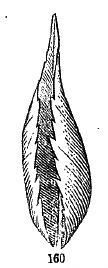
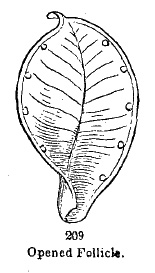

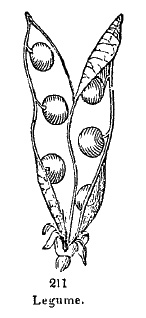
235. A Follicle is such a simple pod which opens down one side only.
The pods of Peony, Columbine, and Marsh-Marigold (Fig. 210) are follicles.
236. A Legume is a pod of a simple pistil, which splits into two pieces. It is the fruit of the Pea or Pulse family.
Fig. 211 is a legume of the Pea, open, separated into its two valves.
237. A Capsule is the pod of any compound pistil.
When capsules open regularly, they either split through the partitions, or where these would be, as in the pod of St. John's-wort (Fig. 212); this divides them into so many follicles, as it were, which open down the inner edge;
or else they split open into the back of the cells, as in the pods of the Lily, the Iris (Fig. 213), &c.
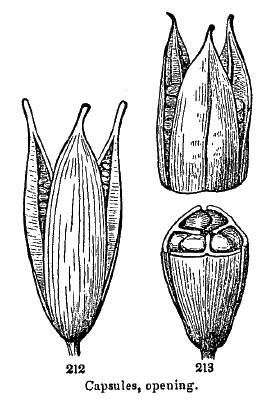
238. The pieces into which a pod splits are called its Valves.
So a follicle (Fig. 210) is one-valved;
a legume (Fig. 211), two-valved;
the capsules in Fig. 212 and 213, both three-valved, &c.
239. Two or three forms of capsule have peculiar names. The principal sorts are the Silique, the Silicle, and the Pyxis.
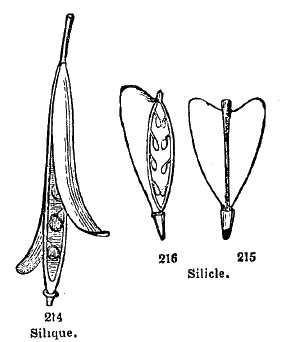
240. A Silique (Fig. 214) is the pod of the Cress family. It is slender, and splits into two valves or pieces, leaving behind a partition in a frame which bears the seeds.
241. A Silicle or Pouch is only a silique not much longer than broad.
Fig. 215 is the silicle of Shepherd's Purse, Fig. 216, the same with one valve fallen.
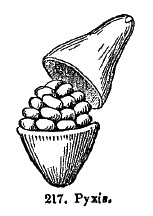
242. A Pyxis is a pod which opens crosswise, the top separating as a lid.
Fig. 217 shows it in the Common Purslane , the lid falling off.
243. There remain a few sorts of fruits which are more or less compound or complex. They may be classed under the heads of Aggregated, Accessory, and Multiple fruits.
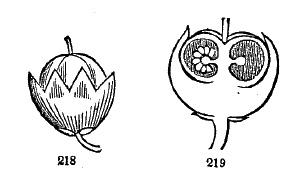
244. Aggregated Fruits are close clusters of simple fruits all of the same flower. The raspberry and the blackberry are good examples. In these, each grain is a drupelet or stone-fruit, like a cherry or peach on a very small scale.
245. Accessory Fruits are those in which the flesh or conspicuous part belongs to some accessory (i.e., added or altered) part, separate from the seed-vessel. What we eat as the fruit is not the fruit at all in a strict botanical sense, but a calyx, receptacle, or something else which surrounds or accompanies it.
Our common checkerberry is a simple illustration. Here the so-called berry is a free or separate calyx, ·which after flowering becomes thick and fleshy, and encloses the true seed-vessel, as a small pod within.
Fig. 218 shows the young pod, partly covered by the loose calyx. Fig. 219 is the ripe checkerberry, cut through the middle lengthwise, the calyx now thick, juicy, and eatable, and enlarged so as to enclose the small, dry pod.

246. A Rose-hip (Fig. 220) is a kind of accessory fruit, looking like a pear or a haw. But it consists of the tube of the calyx, lined by a hollow receptacle, which bears the real fruits, or seed-vessels, in the form of bony akenes.
Fig. 221, a rose-hip when in flower, cut through lengthwise, shows the whole plan of it; the pistils are seen attached to the sides of the urn-shaped receptacle, and their styles, tipped with the stigmas, project a little from the cavity, near the stamens, which are borne on the rim of the deep cup.
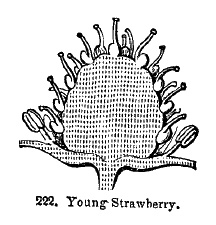
247. A Strawberry is an accessory fruit of a different shape. Fig. 222 is a forming one, at flowering time, divided lengthwise; below is a part of the calyx; above this, a large oval or conical receptacle, its whole surface covered with little pistils. In ripening this grows vastly larger, and becomes juicy and delicious. In fact, what is called a berry is only the receptacle of the flower, or the end of the flower-stalk, grown very large and juicy, and not a seed-vessel at all, but bearing plenty of one-seeded dry seed-vessels (akenes, 229), so small that they are mistaken for seeds.
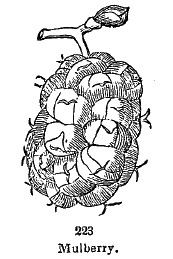
248. Multiple Fruits are masses of simple or accessory fruits belonging to different flowers, all compacted together.
Mulberries (Fig. 223) are of this sort. They look like blackberries, but each grain belongs to a separate flower; and the eatable pulp is not even the seed-vessel of that, but is a loose calyx grown pulpy, just like that of Checkerberry, and surrounding an akene, which is generally taken for a seed. The pine-apple is much like a mulberry on a large scale.
A fig is a multiple fruit, being a hollow flower-stalk grown pulpy, the inside lined by a great number of minute flowers.
249. So, under the name of fruit very different things are eaten. In figs it is a hollow flower-stalk; in pine-apples and mulberries, clusters of flower-leaves, as well as the stalk they cover; in strawberries, the receptacle of a flower; in blackberries, the same, though smaller, and a cluster of little stone-fruits that cover it; in raspberries, the little stone-fruits in a cluster, without the receptacle. In checkerberries, quinces, and (as to all but the core) apples and pears, we eat a fleshy enlarged calyx; in peaches and other stone~fruits, the outer part of a seed-vessel; in grapes, gooseberries, blueberries, and cranberries, the whole seed-vessel, grown rich and pulpy.
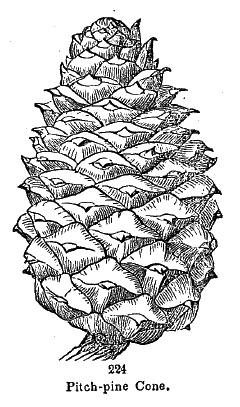
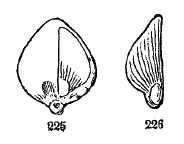
250. The Cone of Pine (Fig. 224) and the like is a sort of multiple fruit. Each scale is a whole pistillate flower, consisting of an open pistil leaf, ripened, and bearing on its upper face one or two naked seeds, as explained at the end of the last section (218, 219).
Fig. 225 shows the upper side of one of the thick scales taken off, bearing one seed; the other, removed, is shown, with its wing, in Fig. 226.
§ 2. Seeds.
252. A Seed is an ovule fertilized and matured, and with a germ or embryo formed in it.
253. In the account of the growth of plants from the seed, at the beginning of the book (Chapter I. Section I.), seeds have already been considered sufficiently for our purpose. As the pupil advances farther in his botanical studies, he will learn much more about them, as well as about fruits and flowers, in the Lessons in Botany, and other works.
254. A seed consists of its Coats and its Kernel. Besides the true seed-coats, which are those of the ovule, an outer loose covering, generally an imperfect one, is occasionally superadded while the seed is growing. This is called an Aril.
Mace is the aril of the nutmeg. The scarlet pulpy covering of the seeds of the Strawberry-tree and the Staff-tree or Waxwork is also an aril.
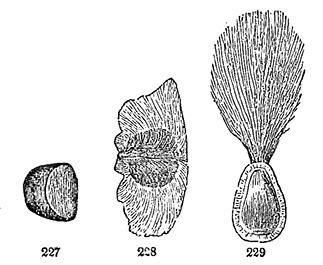
255. The Seed-Coats are commonly two, an outer and an inner; the latter generally thin and delicate.
The outer coat is sometimes close and even, and fitted to the kernel, as in Morning-Glory (Fig. 227); sometimes it is furnished with a tuft of long hairs, as in Milkweed (Fig. 229), or else is covered with long woolly hairs, as in the Cotton-plant, where they form that most useful material, Cotton-wool.
In some cases the outer coat is extended into a thin border or wing, as in the Trumpet-Creeper (Fig. 228). Catalpa-seeds have a fringe-like wing or tuft at each end. The seeds of Pines are winged at one end (Fig. 226).
All these tufts and wings are contrivances for rendering such seeds buoyant, so that, when shed, they may be dispersed by the wind. Thistle-down, and the like, is a similar contrivance on the fruit or akene.
256. The seed is often supported by a stalk of its own, the Seed-stalk. Where the seed separates, it leaves a mark, called the Scar or Hilum.
This is conspicuous in a bean and a pea and is remarkably large in a horsechestnut.
257.The Kernel is the whole body of the seed within the coats. It consists of the Embryo, and of the Albumen, when there is any.
258. The Albumen is a stock of prepared food for the embryo to live upon at the outset, in those cases where it has not a similar supply laid up in its cotyledons (32-35, 45).
In Fig. 17, 44, and 49, the seeds have albumen.
In Fig. 25, 32, 40, and 42, they have none, but the whole kernel consists of
259. The Embryo, or rudimentary plantlet in miniature, the body in the seed which grows. To this the seed, the fruit, and the blossom are all subservient.
The albumen of the seed, when there is any, is intended to nourish the embryo when it grows, until it can provide for itself; the seed-coats to protect it, especially after it is shed; the seed-vessel, to protect it and to nourish it while forming; the stamens and pistil, to originate it.
260. The embryo consists of its Radicle or original stemlet, from one end of which the root starts, from the other the stem is continued; also of one or more Cotyledons or Seed-leaves, and often of a Plumule or bud for continuing the stem upwards.
How the embryo grows into a plant was fully explained at the commencement of this book.
Analysis of the Section.
§ 1. KINDS OF FRUIT.
Fruits are
SIMPLE: seed-vessels of one pistil (221)
AGGREGATED: clusters of seed-vessels all of the same flower, (244)
ACCESSORY: the flesh, &c., external to and separate from the pistil, (245-247)
MULTIPLE: composed of the simple or accessory fruits of more than one flower (248)
Simple Fruits are
Fleshy Fruits (222), such as the Berry (223), Pepo (224), Pome (225)
Stone-Fruits, or the Drupe (226)
Dry Fruits (227)
Dry Fruits (227) are
Indehiscent (228), such as Akene (229), Grain (230), Nut (231), Key (232)
Dehiscent, or Pods, 233
Dehiscent, or Pods (233), are
Of a Simple Pistil, such as Follicle (235) and Legume (236)
Of a Compound Pistil, such as Capsule (237), Silique (240), Silicle (241), Pyxis (242)
Multiple Fruits are
Angiospermous, or closed, (219, 248)
Gymnospermous, or naked-seeded (218, 219) -- Cone (250)
§ 2. SEEDS
252. What a seed is. 253. Its nature already considered. 254. Its parts; Aril occasionally met with. 255. Its coats, and the appendages, wings, &c. 256. Seed-stalk and scar. 257. Kernel. 258. Albumen, sometimes present; its office. 259. Embryo, to which all the other parts of the seed, the fruit, and the flower are subservient. 260. Parts of the Embryo: Radicle, or Stemlet; Cotyledons, or Seed-leaves; Plumule, or Bud.
THIS CONCLUDES NAMETHATPLANT'S TWO-CHAPTER EXCERPT OF ASA GRAY'S HOW PLANTS GROW.

